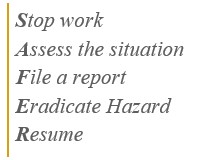In a high-stress situation, we may overlook the safest option in favor of a quicker alternative. Have you ever caught yourself speeding or taking more risks on the road because you were late? Have you ever skipped putting on proper safety equipment because maybe the job was quick and stopping was inconvenient? Sometimes our actions result in an unsafe situation for ourselves or those around us, which could make the workplace especially dangerous. It is easy to recognize when we put ourselves in an unsafe situation, but what about when we see a coworker in an unsafe situation?
The foundation for building a strong safety culture is to create a work environment where all employees feel equally comfortable stopping each other when observing unsafe behavior. Employees should feel comfortable and permitted to discuss safety issues with coworkers and speak up when an unsafe situation is noted. Further, employees working safely should be recognized and encouraged. Positive reinforcement is just as important as constructive criticism.
Follow these steps to help employees become more comfortable with speaking up about safety:
- Start a conversation. Get employees talking about safety topics. Informing employees about safety topics relating to their workplace will encourage conversation.
- Involve leadership. Leadership’s commitment to safety is the first step toward getting employees committed to safety. Management should demonstrate their dedication to safety through their actions and messages.
- Have an open-door policy. The average employee spends at least 40 hours per week at work, and they tend to have a pretty good idea about the hazards they face daily. Encourage employees to bring these topics to management.
- Ensure blame is not placed for near misses or accidents. If an employee feels they will be punished or blamed for an accident or near miss, they are not likely to report it to management. Sometimes employees engage in unsafe behavior because they feel it’s necessary to get the job done on time. Work together to uncover these issues and establish accountability for making important changes.
- Teach employees. Giving and receiving constructive criticism can be uncomfortable. Though the intention isn’t to offend, we may become defensive when another individual tells us we should do a task differently. Training employees on how to have these conversations can help them understand that the intention isn’t to criticize; it is simply a group effort to finish the day safely.
 Simplify the Stop Work process and use a SAFER approach: The SAFER technique keeps your workers safe while optimizing your organization’s efficiency at the same time. Proper recording and following-up of these incidents will help improve workflow for future events. It also keeps your company in line with OSHA standards.
Simplify the Stop Work process and use a SAFER approach: The SAFER technique keeps your workers safe while optimizing your organization’s efficiency at the same time. Proper recording and following-up of these incidents will help improve workflow for future events. It also keeps your company in line with OSHA standards.
When an organization has a strong safety culture, employees are given the authority to stop work they view as unsafe and discuss a safer way to complete the job with their coworkers. There is a continuous safety conversation within these organizations, coming from all employment levels. Safety becomes a regular part of everyone’s day. Building and maintaining a strong safety culture is not easy, and it is not something that happens overnight. The more it is practiced, the more it becomes engrained in your organization.